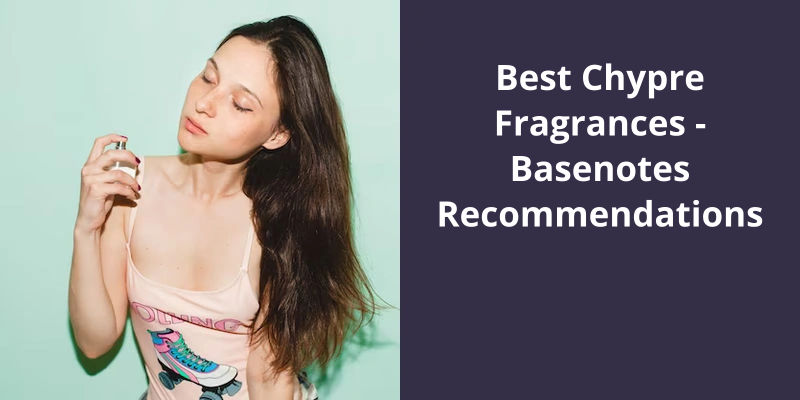The chypre fragrances are a highly loved category in the perfume world due to their warm and mossy base, accentuated by patchouli and oakmoss. Among them, Guerlain Mitsouko, stands out for its unique blend of peach, jasmine, rose, and oakmoss that offer a timeless, captivating scent. Similarly, Clinique’s Aromatics Elixir is a fantastic choice, known for its warm, rose-dominated chypres composition. Another fan-favored is Chanel’s No. 19, an assertive blend of galbanum, iris, and leather. Tom Ford’s Vert Boheme, a floral chypre with key notes of honeysuckle and galbanum, is also a popular pick. François Coty’s Chypre, the scent that started the chypre family of fragrances itself is an iconic one that is very revered, with dominant notes of bergamot, oakmoss, patchouli, and labdanum. It is these rich, varied, and distinctive chypre fragrances that make them so appealing and perennial favorites among perfume enthusiasts.

What Does a Chypre Smell Like?
The richness of a chypre fragrance can vary depending on the ingredients used. It often incorporates oakmoss, which gives it a mossy, forest-like quality. This is combined with patchouli for a richer, earthy aroma. Sandalwood and vetiver are also commonly used in chypre scents to add depth and complexity. These ingredients come together to create a scent that’s both elegant and sophisticated.
Chypre fragrances also often feature fruity notes such as bergamot, lemon, and peach. These provide a sharp and refreshing opening to the scent, before the floral heart notes take over. The florals used in chypre fragrances tend to be more traditional, such as jasmine, rose, and ylang-ylang. These floral notes blend seamlessly with the earthier base notes, creating a well-rounded, complex scent that’s perfectly balanced.
One thing that sets chypres apart from other fragrance families is the surprising way in which they can appeal to both men and women. This makes it a versatile and universally loved fragrance family.
It includes fruity top notes, traditional floral heart notes, and an earthy base of oakmoss, patchouli, sandalwood, and vetiver. The resulting scent is both elegant and versatile, making it a timeless classic that will never go out of style.
The Different Sub-Categories of Chypre Fragrances – Such as Floral Chypres, Fruity Chypres, Green Chypres, Etc. – And How They Differ in Terms of Their Ingredients and Character.
Chypre fragrances have different sub-categories such as floral, fruity, and green chypres. These sub-categories have different ingredients and character that set them apart from each other.
The classification of chypre fragrances encompasses some of the most iconic scents in the perfume world, including those from Guerlain and Chanel. However, due to restrictions on certain ingredients, the traditional chypre scent is becoming harder to come by.
Which Chanel Perfume Is a Chypre?
Chanel No. 22 is a chypre floral fragrance that was first introduced in 1922 by the legendary fashion house. The perfume was created by Ernest Beaux, the same perfumer who created Chanel No. 5, and it quickly became a classic in it’s own right. Chanel No. 22 features notes of of white flowers, jasmine, and rose, as well as woody and spicy notes, which give it it’s characteristic chypre aroma.
Chypre fragrances are known for their complex, multi-layered scent profiles. They typically feature a blend of citrus, floral, and woody notes, along with a heavy dose of oak moss and patchouli. The resulting scent is rich and earthy, with a slightly bitter undertone. Chypre fragrances are often referred to as “feminine” or “masculine”, as they can be worn by both men and women.
While many perfumes in the chypre family have been discontinued due to IFRA regulations, Chanel has found a way to continue producing their iconic chypre fragrances without sacrificing their signature scent. By using synthetic versions of oak moss and other ingredients that are now restricted, Chanel has been able to maintain the quality and depth of their chypre fragrances.
This fragrance features notes of iris, vetiver, and oak moss, along with floral and citrus notes. It’s a complex and sophisticated scent that’s become a favorite among Chanel aficionados.
Although chypre fragrances aren’t as prevalent as they once were, they’re still highly regarded by perfume lovers around the world. And for those who’re looking for a classic chypre fragrance, Chanel has some of the best options available.
What Should You Consider When Buying a Chypre Fragrance?
- Notes: Consider the notes used in the fragrance. Chypre fragrances typically have a combination of citrus, floral, and mossy notes.
- Longevity: Look for a fragrance with good longevity so that it lasts throughout the day.
- Sillage: Consider the sillage, or the trail of scent left behind. Chypre fragrances are known for their moderate to heavy sillage.
- Occasion: Think about when and where you’ll be wearing the fragrance. Chypre fragrances are commonly associated with fall and winter, and they work well for evening events.
- Personal Preference: Ultimately, choose a fragrance that you enjoy and that fits your personal style.
For fragrance lovers, chypre perfumes hold a unique allure. With their signature blend of citrus, oakmoss, and labdanum, these scents deliver a sense of sophistication and mystery. From the iconic Miss Dior by Christian Dior to the modern classic Coco Mademoiselle by Chanel, the chypre category includes some of the most recognizable and beloved fragrances in the world. Here are some of the top chypre perfumes to explore.
Which Fragrances Are Chypre?
Chypre fragrances have been a long-standing tradition in the world of perfumery. These fragrances are defined by their complex olfactory profile, featuring top notes of citrus and bergamot, heart notes of jasmine and patchouli, and base notes of oakmoss and labdanum. This unique combination gives them a distinct, earthy scent that’s been sought after by fragrance enthusiasts for decades.
One of the most iconic chypre perfumes is Miss Dior by Christian Dior. Since it’s launch in 1947, it’s been a favorite of women around the world. The fragrance features a blend of chypre notes and floral scents like rose and jasmine, making it perfect for both day and evening wear. It’s sophisticated and elegant aroma has made it a timeless classic.
Another iconic chypre fragrance is Mitsouko by Guerlain. Launched in 1919, this fragrance has withstood the test of time and remains a favorite of many. It features notes of bergamot, jasmine, and oakmoss, giving it a unique and complex aroma. Mitsouko is known for it’s deep, woody scent and has been honored as one of the greatest fragrances of all time.
Femme by Rochas is another notable chypre fragrance. It was launched in 1944 and has remained popular among perfume enthusiasts for it’s rich and complex aroma. Femme features a mix of floral and fruity scents, including peach and plum, balanced by a base of oakmoss and patchouli. It’s a classic chypre fragrance that exudes sophistication and elegance.
Cabochard by Grès is another chypre fragrance that’s stood the test of time. This fragrance was created in 1959 and is known for it’s bold and daring aroma. It features scents like leather, bergamot, and oakmoss, giving it a distinctly earthy scent. Cabochard is a fragrance for bold and confident women who arent afraid to make a statement.
Aromatics Elixir by Clinique is a chypre fragrance that’s both spicy and floral. Launched in 1971, it remains a favorite of many. Aromatics Elixir is perfect for those who love bold and spicy scents that last all day.
Finally, Coco Mademoiselle by Chanel is a modern take on the classic chypre fragrance. It was launched in 2001 and is known for it’s playful and feminine aroma. Coco Mademoiselle features notes of bergamot, orange, and rose, balanced by a base of patchouli and vetiver. It’s a fragrance for modern women who want a scent that’s both playful and sophisticated.
The Different Variations of Chypre Fragrances, Including Chypre Floral and Chypre Leather.
- Chypre Floral Fragrances
- Chypre Leather Fragrances
Now that we’ve explored the basics of what a chypre fragrance is composed of, it’s time to take a closer look at the history of this perfume category and how it’s evolved over time. From it’s origins in the early 20th century to it’s continued popularity among fragrance enthusiasts today, chypre fragrances have a fascinating story to tell. So, let’s dive in!
What Does Chypre Fragrance Mean?
The word “chypre” itself is French for Cyprus, a Mediterranean island known for it’s cypress trees. However, the fragrance style was actually born in France in the early 20th century, and was popularized by one of the great French perfumers, François Coty. He was inspired by the scents of the Mediterranean, specifically the island of Cyprus, which he visited and fell in love with.
Chypre fragrances are characterized by their complex scent profile, which begins with bright, fresh citrus notes such as bergamot or lemon, and is anchored by a woody or resinous heart note such as oakmoss or labdanum. These scents are often balanced by floral or spicy notes, which lend depth and interest. The result is a fragrance that’s both sophisticated and sensual.
One of the reasons that chypre fragrances are so beloved is their versatility. They can be worn year-round, and can easily be dressed up or down depending on the occasion. They pair well with everything from jeans and a t-shirt to a formal gown, making them an ideal choice for anyone who wants a signature scent that they can wear every day.
Today, there are countless variations on the chypre theme, from bright and citrusy to dark and mysterious, ensuring that there’s a chypre fragrance out there for everyone. Whether youre a die-hard chypre fan or just discovering the scent, there’s never been a better time to explore this timeless fragrance family.
Different Variations of Chypre Fragrances and Their Key Characteristics
Chypre fragrances are a type of perfume that typically include bergamot, oakmoss, and labdanum, and can have various other ingredients added to create different variations. Some common variations include fruity chypres, floral chypres, and woody or mossy chypres. Each variation has it’s own unique scent profile, with fruity chypres typically having a lighter, fresher scent and woody chypres having a darker, earthier scent. Key characteristics of chypre fragrances include their strong, long-lasting scent and their complexity, with multiple layers of ingredients that create a rich, nuanced fragrance.
Source: Chypre – Wikipedia
Understanding the terminology used in the world of fragrance is crucial to appreciating the art of perfumery. When perfumers describe the various components that make up the scent of a fragrance, they often refer to them as top, middle, and base notes. These descriptors illustrate the way in which fragrance unfolds over time and, by doing so, creates a unique olfactory experience. In this article, we delve deeper into what these terms mean and how they help us understand the complex world of scent.
What Is Meant by Top Middle and Base Notes in Perfume?
The top notes are the initial scents that one smells in a perfume. They’re usually the lighter, more volatile ingredients that evaporate quickly. They tend to be fresh and fruity, providing an immediate burst of fragrance. These scents are the ones you smell first when you spray a perfume and they usually last only a few minutes. They can include citrus, bergamot, lavender or other bright scents.
The base notes are the last to appear in a fragrance. They provide the foundation for a fragrance, adding depth and staying power. These scents can include musk, vanilla, sandalwood or other heavy, earthy aromas.
The combination of these three types of scents is what creates a fragrance that’s both unique and long-lasting. A skilled perfumer will carefully balance these notes to create a fragrance that’s pleasing to the nose and enjoyable to wear. They’ll also consider how the fragrance will develop over time, as the top notes evaporate and the middle and base notes become more prominent.
When choosing a perfume, it’s important to consider all three types of notes and how they’ll interact with your body chemistry. The top notes may smell great on someone else but not work well on your skin. The middle notes may be too overpowering or the base notes too earthy for your liking. It’s all about finding the right balance and combination for you.
The Role of Middle Notes in Perfumes: Middle Notes, Also Known as Heart Notes, Make Up the Core Scent of a Fragrance. They Are Responsible for the Overall Character and Theme of the Perfume. This Section Can Discuss How Middle Notes Are Typically Floral, Spicy, or Herbal and How They Complement the Top and Base Notes.
Middle notes are the heart of a fragrance and give it it’s overall character and theme. They’re typically floral, spicy, or herbal, and they complement the top and base notes.
Conclusion
These fragrances have stood the test of time and continue to entice and captivate those who seek sophistication and elegance in their scent.





